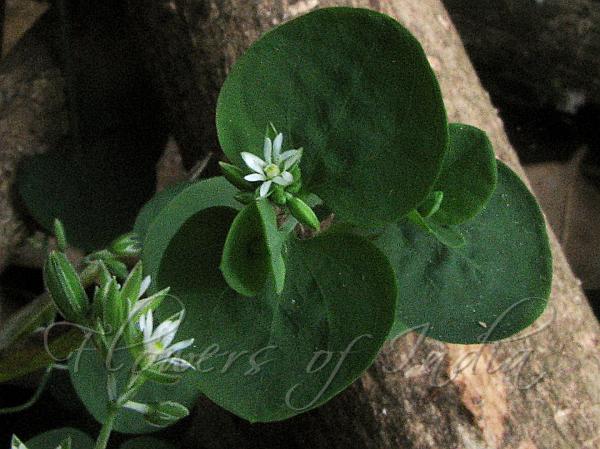|
| Tropical Chickweed |
|

|

| File size | 369294 |
| Original date | 1/25/14 9:38 AM |
| Resolution | 1320 x 990 |
| Flash | Flash did not fire, auto |
| Focal length | 6.0mm |
| Exposure time | 1/50s |
| Aperture | 3.2 |
| Focus Distance | |
| Metering Mode | Multi-segment |
| Camera make | Canon |
| Camera model | Canon PowerShot S5 IS |
| Sensor type | OneChipColorArea |
|
|
|
|
Photo: |
Botanical name: Drymaria cordata Family: Caryophyllaceae (Carnation family)
Synonyms: Stellaria adenophora, Drymaria procumbens, Alsine rotundifolia
Synonyms: Stellaria adenophora, Drymaria procumbens, Alsine rotundifolia
Tropical Chickweed is a prostrate herb with
dichotomous branching. Leaves are very broadly ovate, almost round,
with heart-shaped base, carried on stalks up to 1 cm. Leaves are
hairless, 1-3.5 x 0.6-3 cm, 3-7-nerved at base. Tiny flowers are borne
in cymes at branch ends or in leaf axils, often loose on long slender
stalks and with slender branches. Sepals are narrowly lanceshaped,
green with white margin. Petals are white, about 3 mm, very deeply
divided into two. Tropical Chickweed is native to Africa, America
and Asia. Tender leaves and shoots are eaten as vegetable with small
dry fish in NE India. It is found in the Himalayas at altitudes of 200-2400 m.
Medicinal uses:  The pounded leaf is applied to snake bites in China. The plant is
appetizer, depurative, emollient, febrifuge, laxative and stimulant.
The juice of the plant is used. Tropical Chickweed is widely used in
traditional African medicine for the treatment of diverse ailments
including painful and febrile conditions.
The pounded leaf is applied to snake bites in China. The plant is
appetizer, depurative, emollient, febrifuge, laxative and stimulant.
The juice of the plant is used. Tropical Chickweed is widely used in
traditional African medicine for the treatment of diverse ailments
including painful and febrile conditions.
 The pounded leaf is applied to snake bites in China. The plant is
appetizer, depurative, emollient, febrifuge, laxative and stimulant.
The juice of the plant is used. Tropical Chickweed is widely used in
traditional African medicine for the treatment of diverse ailments
including painful and febrile conditions.
The pounded leaf is applied to snake bites in China. The plant is
appetizer, depurative, emollient, febrifuge, laxative and stimulant.
The juice of the plant is used. Tropical Chickweed is widely used in
traditional African medicine for the treatment of diverse ailments
including painful and febrile conditions. | Identification credit: Siddarth Machado | Photographed in Chikmagalur, Karnataka & Soureni, Mirik, Darjeeling area. |
• Is this flower misidentified? If yes,